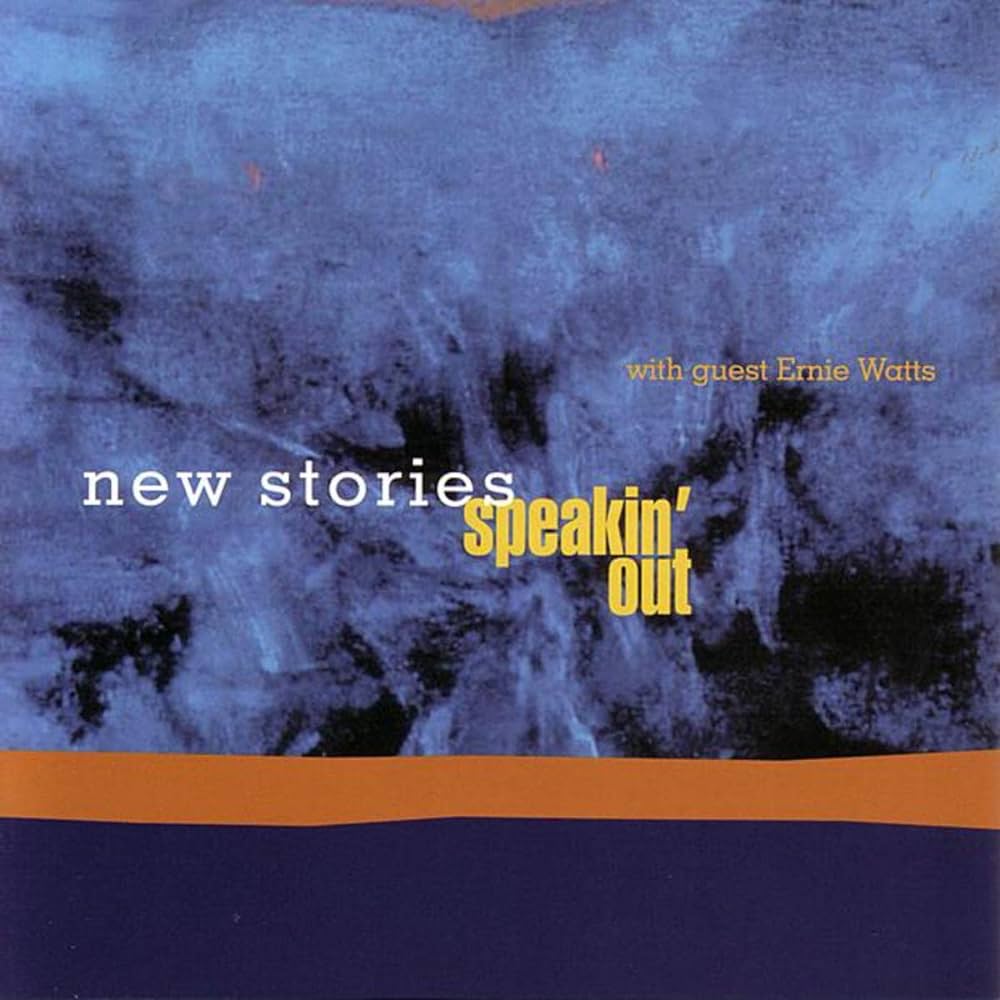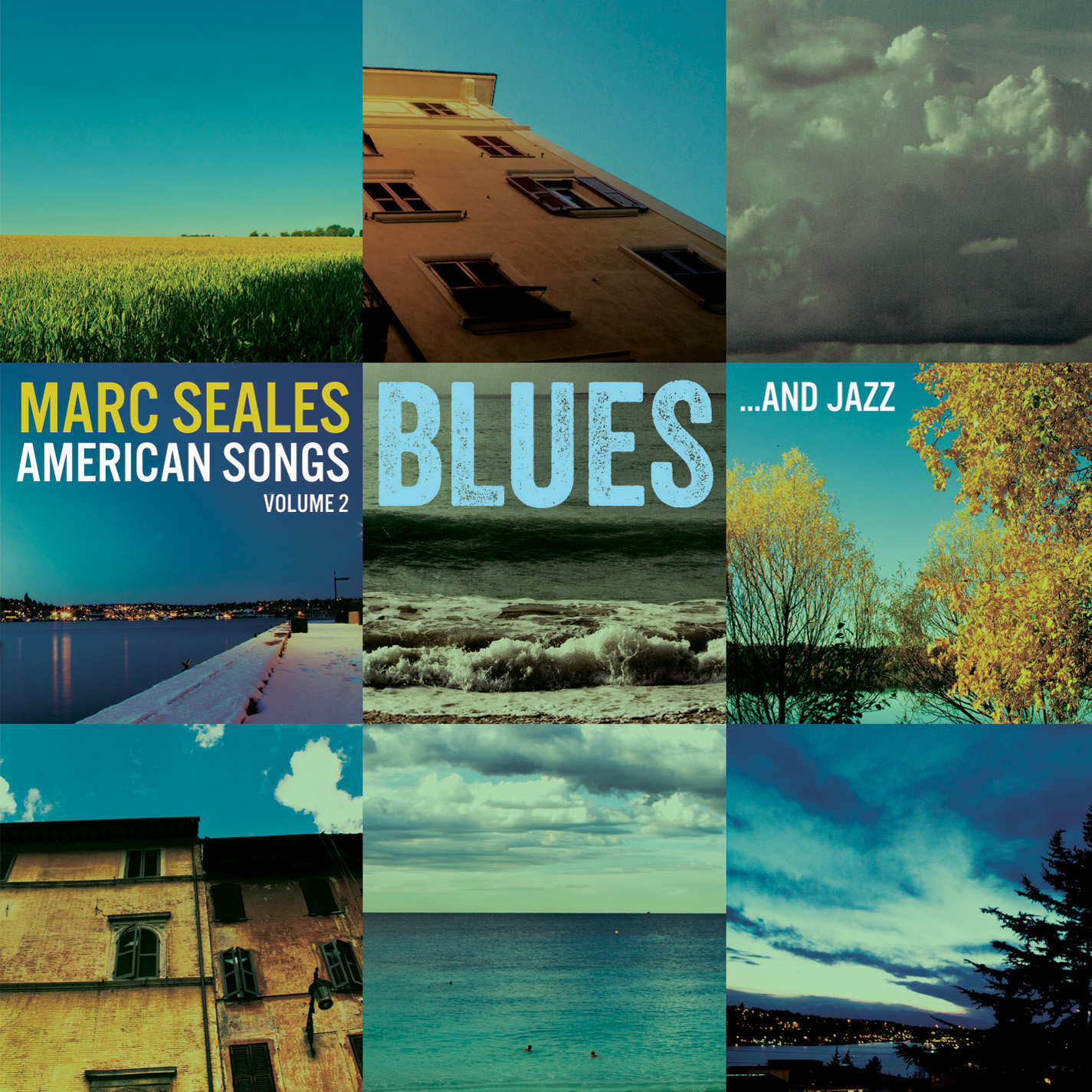Blue – Marc Seales
An open-ended song, lyrical though without a key center. Marc Seales recorded this song in a few different settings; we have condensed scores for three recordings.
- Recording: New Stories - Speakin' Out
- Recorded on: January 24, 1999
- Label: Origin (82372)
- Concert Key: No key center
- Vocal Range: , to
- Style: Even 8ths (medium)
- Saxes - Ernie Watts
- Piano - Marc Seales
- Bass - Doug Miller
- Drums - John Bishop
Video
- Description
- Historical Notes
- Solos
- Piano Corner
- Bass Corner
- Drum Corner
- Guitar Corner
- Inside & Beyond
- Minus You
For a detailed description of this song, click on the second album cover ("American Songs"). This version by New Stories, with guest Ernie Watts on tenor sax, has a slightly different quartet arrangement. A condensed score is available for this recording as well as a tenor part. This arrangement stays in time, with no rubato at A. The piano doubles the tenor melody in this section; there are drum fills in both the in and out heads. At B the tenor has the melody alone; the piano adds octaves in the right hand to the left-hand voicings. The third and fourth measures of C add piano chords not played in other versions.
D is again a piano solo; the tenor plays the background only on the last time. The tenor is the second soloist; though we show the same bass line at 1 as on the "American Songs" version it is interpreted more freely here. After this solo the tenor cues E (the interlude); the piano joins in the third measure with unison melody plus chord voicings.
On the out head B is repeated, going to the coda the second time. The coda starts with piano and tenor trading eight measures each of the vamp; they play the melody together the last time only.
D is again a piano solo; the tenor plays the background only on the last time. The tenor is the second soloist; though we show the same bass line at 1 as on the "American Songs" version it is interpreted more freely here. After this solo the tenor cues E (the interlude); the piano joins in the third measure with unison melody plus chord voicings.
On the out head B is repeated, going to the coda the second time. The coda starts with piano and tenor trading eight measures each of the vamp; they play the melody together the last time only.
"Speakin' Out" is the fourth New Stories album. Between the two sessions, Ernie Watts recorded with Charlie Haden's Quartet West on "The Art Of Song," the seventh album by this quartet and their last until "Sophisticated Ladies" from 2010.
Click on the third album cover for a live version of this song, with a video, featuring the same lineup as on "Speakin' Out" but recorded 20 years later.
Click on the third album cover for a live version of this song, with a video, featuring the same lineup as on "Speakin' Out" but recorded 20 years later.
Related Songs
Email Send Blue to a friend
Send this page to a friend via email. Add your name or email in the first field. In the second, add one or more email addresses, separated by a comma.
- Recording: Marc Seales - American Songs: Blues . . . And Jazz, volume 2
- Recorded on: May 26-27, 2012
- Label: Origin (82658)
- Concert Key: No key center
- Vocal Range: , to
- Style: Even 8ths (medium)
- Guitar - Fred Hamilton
- Piano - Marc Seales
- Bass - Jeff Johnson
- Drums - Gary Hobbs
Video
- Description
- Historical Notes
- Solos
- Piano Corner
- Bass Corner
- Drum Corner
- Guitar Corner
- Inside & Beyond
- Minus You
Not a blues! Blue is an open-ended song, more harmonic than melodic with no obvious key center. The melody winds around chromatically, but becomes momentarily lyrical and wistful; these latter sections suggest an A minor tonality. The harmonies are impressionistic and colorful; in some places with shifting piano chords over a bass vamp, we show no chord symbol.
The form has several contrasting sections. The two eight-measure A sections alternate two measures each of 3/4 and 4/4, the latter having single long chords with fills. An A bass pedal introduces the 16-measure B section; the melody comes in on the fifth measure. The C section, played once on the in head only, is seven measures long with the bass doubling the melody.
Solos are on an eight-measure section based on the last four measures of the B section. A chromatic rising line in whole notes is played as a background here—on this recording a guitar background for the piano solo. This leads to a guitar solo over A pedal in the bass. After the last solo there is an interlude (over the same pedal)—the only part of the song with a somewhat bluesy melody. This leads back to the out head: two A sections and one B, vamping the last four measures to end.
A condensed score is available which reflects this recording. The A sections of the in head in this version are rubato, with piano and guitar fills together; on the out head these sections are in time with drum fills instead. The piano and guitar generally play the melody in octaves; on the ending vamp they alternate between playing the melody and soloing.
The form has several contrasting sections. The two eight-measure A sections alternate two measures each of 3/4 and 4/4, the latter having single long chords with fills. An A bass pedal introduces the 16-measure B section; the melody comes in on the fifth measure. The C section, played once on the in head only, is seven measures long with the bass doubling the melody.
Solos are on an eight-measure section based on the last four measures of the B section. A chromatic rising line in whole notes is played as a background here—on this recording a guitar background for the piano solo. This leads to a guitar solo over A pedal in the bass. After the last solo there is an interlude (over the same pedal)—the only part of the song with a somewhat bluesy melody. This leads back to the out head: two A sections and one B, vamping the last four measures to end.
A condensed score is available which reflects this recording. The A sections of the in head in this version are rubato, with piano and guitar fills together; on the out head these sections are in time with drum fills instead. The piano and guitar generally play the melody in octaves; on the ending vamp they alternate between playing the melody and soloing.
This is the third recording of Blue. Bassist Jeff Johnson also played on the first version, from drummer Steve Korn's 1999 album "Here And Now." Marc also recorded this song later in 1999 on "Speakin' Out" by the New Stories trio with guest saxophonist Ernie Watts; click on the first album cover for this version.
Related Songs
Email Send Blue to a friend
Send this page to a friend via email. Add your name or email in the first field. In the second, add one or more email addresses, separated by a comma.
- Recording: Marc Seales - Blue - Marc Seales - Ballard Jazz Festival
- Recorded on: August 7, 2019
- Label: KNKX Public Radio (8-7-2019)
- Concert Key: No key center
- Vocal Range: , to
- Style: Even 8ths (medium)
- Tenor Sax - Ernie Watts
- Piano - Marc Seales
- Bass - Doug Miller
- Drums - John Bishop
- Description
- Historical Notes
- Solos
- Piano Corner
- Bass Corner
- Drum Corner
- Guitar Corner
- Inside & Beyond
- Minus You
Yet another arrangement of Blue, combining elements of the other quartet recordings, 20 years after the first recording. At A of the in head, only the rhythm section plays in the 3/4 measures; the tenor plays fills on the 4/4 measures. This section is not played entirely rubato, but the chords under the tenor fills are held out (shown in our Condensed Score with a wiggly line rather than a fermata). On the out head A has the same format as on the "Speakin" Out" recording (first album cover), with tenor melody and drum fills.
The piano and tenor double the melody in octaves at B, which is played twice in and once out. Marc Seales plays the same rhythmic fill in the seventh and eighth measures each time, which is shown in our score. There are no piano chords at C.
The solo format is the mostly the same as on "Speakin' Out," but with the tenor playing the backgrounds twice at the end of the piano solo. At E the piano doubles the tenor again, with a few more chord hits. The coda starts with piano and tenor melody in octaves; they then trade 4s and play the melody once more to end.
The piano and tenor double the melody in octaves at B, which is played twice in and once out. Marc Seales plays the same rhythmic fill in the seventh and eighth measures each time, which is shown in our score. There are no piano chords at C.
The solo format is the mostly the same as on "Speakin' Out," but with the tenor playing the backgrounds twice at the end of the piano solo. At E the piano doubles the tenor again, with a few more chord hits. The coda starts with piano and tenor melody in octaves; they then trade 4s and play the melody once more to end.
The Ballard Jazz Festival in Seattle is presented by Origin Records, the label founded by drummer John Bishop. This particular set was a 20th anniversary celebration of New Stories' "Speakin' Out" album.
Related Songs
Email Send Blue to a friend
Send this page to a friend via email. Add your name or email in the first field. In the second, add one or more email addresses, separated by a comma.

Marc Seales
born on July 23, 1954
A noted pianist, composer and leading figure in the Northwest jazz scene, Marc Seales has shared stages with many of the great players of the last two decades. He has played with nearly every visiting jazz celebrity from Joe Henderson and Art Pepper to Benny Carter, Mark Murphy, and Bobby Hutcherson. With the late Don Lanphere he performed in such places as London, England; Kobe, Japan; The Hague in the Netherlands; and the North Sea Jazz Festival. Read more...
There was a problem.
...





